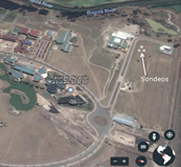Spatial variability of the Sabana de Bogotá clayed soil in reliability of primary consolidation settlements Variabilidad espacial de arcillas en la confiabilidad de asentamientos
Main Article Content
Keywords
Monte Carlo simulations, Settlement probability curves, Soil consolidation, Uncertainty
Abstract
The aim of this paper is to present a reliability study of the consolidation parameters of a clayed soil from the "Sabana de Bogotá" sector. The work methodology included the extraction of clay undisturbed samples and the development of an experimental plan in the laboratory, which included thirty oedometric tests. In addition, the probability distributions of the consolidation parameters for the "Sabana de Bogotá" soil were estimated. Results allowed obtaining the variability of the compressibility properties of such materials. Otherwise, Monte Carlo simulations were performed in order to estimate settlement reliability curves. It was found that the settlement magnitude in the "Sabana de Bogotá" clayed soils is affected by the spatial variability of the compressibility properties of this kind of soil.
Downloads
References
[2] A. Viana da Fonseca, J. Carvalho, C. Ferreira, E. Costa, C. Tuna, and J. A.Santos, “Geotechnical characterization of a residual soil profile: the ISC’2 experimental site, FEUP,” inGeotechnical and Geophysical Site Characteri-zation: Proceedings of the Second International Conference on Site Charac-terization, ISC-2 Porto, Portugal, A. Viana da Fonseca and P. W. Mayne,Eds. Porto: 9059660099, 2004, pp. 1361–1369. 180
[3] G. A. Fenton and D. V. Griffiths, “Probabilistic Foundation Settlementon Spatially Random Soil,”Journal of Geotechnical and GeoenvironmentalEngineering, vol. 128, no. 5, pp. 381–390, may 2002. [Online]. Available:https://doi.org/10.1061/(ASCE)1090-0241(2002)128:5(381) 181
[4] ——, “Three-Dimensional Probabilistic Foundation Settlement,”Journalof Geotechnical and Geoenvironmental Engineering, vol. 131, no. 2, pp.232–239, feb 2005. [Online]. Available: https://doi.org/10.1061/(ASCE)1090-0241(2005)131:2(232) 181
[5] L. Houy, D. Breysse, and A. Denis, “Influence of soil heterogeneity on loadredistribution and settlement of a hyperstatic three-support frame,”Géotech-nique, vol. 55, no. 2, pp. 163–170, mar 2005. 181
[6] T. Al-Bittar and A.-H. Soubra, “Probabilistic Analysis of Strip FootingsResting on Spatially Varying Soils and Subjected to Vertical or InclinedLoads,”Journal of Geotechnical and Geoenvironmental Engineering, vol.140, no. 4, p. 4013043, 2014. [Online]. Available: https://doi.org/10.1061/(ASCE)GT.1943-5606.0001046 181
[7] F. Prada, A. Ramos, D. Solaque, and B. Caicedo, “Confiabilidad aplicadaal diseño geotécnico de un muro de contención,”Obras y proyectos,no. 9, pp. 49–58, 2011. [Online]. Available: http://dx.doi.org/10.4067/S0718-28132011000100006 181
[8] R. Y. Rubinstein and D. P. Kroese,Simulation and the Monte Carlo Method,ser. Wiley Series in Probability and Statistics. Hoboken, NJ, USA: JohnWiley & Sons, Inc., 2007. 182
[9] M. Sánchez-Silva and G.-A. Klutke,Reliability and Life-Cycle Analysis ofDeteriorating Systems, 1st ed. Springer International Publishing, 2016. 182
[10] M. Sánchez-Silva,Introducción a la confiabilidad y evaluación de riesgos:teoría y aplicaciones en ingeniería. Bogotá: Universidad de los Andes, 2010.182
[11] K.-K. Phoon and J. Ching,Risk and Reliability in Geotechnical Engineering.London: CRC Press/Taylor & Francis, 2015. 182, 197
[12] G. B. Baecher and J. T. Christian,Reliability and statistics in geotechnicalengineering, 1st ed. Wiley, 2003. 182
[13] K.-K. Phoon and F. H. Kulhawy, “Characterization of geotechnicalvariability,”Canadian Geotechnical Journal, vol. 36, no. 4, pp. 612–624, nov1999. [Online]. Available: https://doi.org/10.1139/t99-038 183, 199, 201
[14] J. Huang, D. V. Griffiths, and G. A. Fenton, “Probabilistic Analysis ofCoupled Soil Consolidation,”Journal of Geotechnical and Geoenvironmen-tal Engineering, vol. 136, no. 3, pp. 417–430, mar 2010. 183
[15] T. Bong and A. W. Stuedlein, “Efficient methodology for probabilistic analy-sis of consolidation considering spatial variability,”Engineering Geology, vol.237, pp. 53–63, 2018. 183, 199
[16] F. A. Molina Gómez, J. F. Camacho-Tauta, and O. J. Reyes-Ortiz,“Stiffness of a granular base under optimum and saturated water contents,”Revista Tecnura, vol. 20, no. 49, p. 75, jul 2016. [Online]. Available: http://revistas.udistrital.edu.co/ojs/index.php/Tecnura/article/view/10973 185
[17] O. Coronado, B. Caicedo, S. Taibi, A. G. Correia, and J.-M. Fleureau, “Amacro geomechanical approach to rank non-standard unbound granular ma-terials for pavements,”Engineering Geology, vol. 119, no. 1-2, pp. 64–73,2011. 185
[18] ASTM International, “D854 - Standard Test Methods for Specific Gravity ofSoil Solids by Water Pycnometer,” pp. 1–8, 2014. 186
[19] ——, “ASTM D2216 Standard Test Methods for Laboratory Determinationof Water (Moisture) Content of Soil and Rock by Mass,” pp. 1–7, 2010. 186
[20] ——, “D4318 - Standard Test Methods for Liquid Limit, Plastic Limit, andPlasticity Index of Soils,” pp. 1–14, 2010. 186
[21] ——, “D422 - Standard Test Method for Particle-Size Analysis of Soils,” pp.1–8, 2007. 186
[22] ——, “ASTM D2435 - Standard Test Methods for One-Dimensional Con-solidation Properties of Soils Using Incremental Loading,” pp. 1–15, 2011.187
[23] D. W. Taylor,Research on Consolidation of Clays. Massachusetts Instituteof Technology, 1942. 187
[24] D. D. Wackerly, W. Mendenhall, and R. L. Scheaffer,Mathematical statisticswith applications. Thomson Brooks/Cole, 2008. 188
[25] ASTM International, “ASTM D2166 - Standard Test Method for UnconfinedCompressive Strength of Cohesive Soil,” pp. 1–7, 2016. [Online]. Available:https://compass.astm.org/download/D2166D2166M.24011.pdf 188
[26] M. L. Delignette-Muller and C. Dutang, “fitdistrplus: An R Package forFitting Distributions,”Journal of Statistical Software, vol. 64, no. 4, pp.1–34, mar 2015. [Online]. Available: http://dx.doi.org/10.18637/jss.v064.i04191
[27] L. F. Orozco, “Asentamientos de fundaciones en la arcilla deBogotá,” inEncuentro de Suelos y Estructuras. Bogotá: EscuelaColombiana de Ingeniería Julio Garavito, 2006, p. 53. [Online]. Available:https://tycho.escuelaing.edu.co/contenido/encuentros-suelosyestructuras/documentos/cimentacion/05_luis_fernando_orozco.pdf 195
[28] J. C. Garzón Rodríguez, “Evaluación de asentamientos por consolidacióngenerada por descenso del nivel freático,” Ph.D. dissertation, UniversidadNacional de Colombia, 2011. [Online]. Available: http://www.bdigital.unal.edu.co/4143/1/296476.2011.pdf 195
[29] J. Ching and K.-K. Phoon, “Correlations among some clay parameters - themultivariate distribution,”Canadian Geotechnical Journal, vol. 51, no. 6, pp.686–704, jun 2014. 197, 199
[30] B. Caicedo, C. Mendoza, F. López, and A. Lizcano, “Behavior ofdiatomaceous soil in lacustrine deposits of Bogotá, Colombia,”Journal ofRock Mechanics and Geotechnical Engineering, vol. 10, no. 2, pp. 367–379,2018. [Online]. Available: https://doi.org/10.1016/j.jrmge.2017.10.005 197,199
[31] J. Ching and K.-K. Phoon, “Modeling parameters of structuredclays as a multivariate normal distribution,”Canadian GeotechnicalJournal, vol. 49, no. 5, pp. 522–545, may 2012. [Online]. Available:https://doi.org/10.1139/t2012-015 197
[32] C. A. Hidalgo and A. Pacheco de Assis, “Herramientas para análisis porconfiabilidad en geotecnia: La teoría,”Revista Ingenierías Universidad deMedellín, vol. 10, no. 18, pp. 69–78, 2011. [Online]. Available: http://revistas.udem.edu.co/index.php/ingenierias/article/view/338 197, 198, 201
[33] T. S. Charlton and M. Rouainia, “A probabilistic approach to the ultimatecapacity of skirted foundations in spatially variable clay,”Structural Safety,vol. 65, pp. 126–136, 2017. 197

